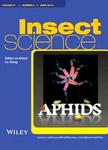Is Tetranychus urticae suitable prey for development and reproduction of nafve Coleomegilla maculata?
Is Tetranychus urticae suitable prey for development and reproduction of nafve Coleomegilla maculata?作者机构:National Biological Control Laboratory Agricultural Research Service USDA 59 Lee Road Stoneville MS 38776 USA
出 版 物:《Insect Science》 (昆虫科学(英文版))
年 卷 期:2014年第21卷第1期
页 面:83-92页
核心收录:
学科分类:0710[理学-生物学] 0830[工学-环境科学与工程(可授工学、理学、农学学位)] 07[理学] 09[农学] 0904[农学-植物保护] 0901[农学-作物学] 090402[农学-农业昆虫与害虫防治] 071002[理学-动物学] 0713[理学-生态学]
主 题:behavior biocontrol CoccineUidae nutrition rearing
摘 要:The lady beetle Coleomegilla maculata De Geer is an omnivorous predator that could help suppress aphid and spider mite populations on plants in greenhouses, plantscapes or interiorscapes. We are assessing the nutritional requirements and feeding behavior of C. maculata on target prey (spider mites) and factitious (unnatural) food. Our ultimate goal is to develop an efficacious diet to mass produce C. maculata. In this study, we tested the hypothesis that Tetranychus urticae Koch (two-spotted spider mite) is not suitable prey for development and reproduction of naive C. maculata (i.e., with no prior exposure to T. urticae). Our objectives were to (i) provide baseline data on the effects of consuming T. urticae on C. maculata life history, (ii) to compare the effects of consuming all stages of T. urticae versus eggs ofMusca domestica L. (common housefly), and (iii) to determine if the consumption of plant products was beneficial. We used C. maculata from a colony reared only on Ephestia kuehniella Zeller (Mediterranean flour moth) eggs. In experiments, C. maculata larvae were reared from the first instar to adult stage with prey/food in replicated arenas; adult females were paired with a single male with prey/food. The results showed that naive C. maculata readily attacked and consumed T. urticae. Nevertheless, T. urticae was less suitable than M. domestica eggs for C. maculata development and reproduction. Applying a synthetic pollen-Chlorella alga powder (SPCA) in arenas containing T. urticae appeared to boost C. maculata female development and reproduction.



